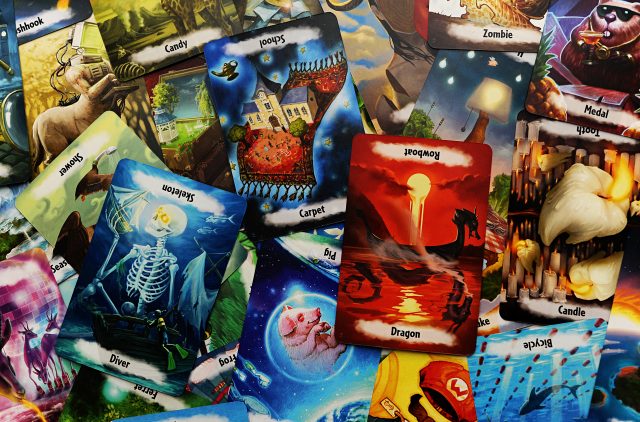I am a big fan of both Communication games and Hidden Identity games, so I was excited to get my hands on a copy of a game that combines both mechanics. When I Dream is a party game on its surface, but it does task players with some deep thinking and strategy. Night has fallen and one player is drifting off to sleep. Their dreams will be filled with fleeting images, but grasping control of them will depend on their ability to find the truth in the words being whispered to them.
 The Dreamer covers their eyes with the Sleep Mask (how fancy) and they rest of the players are dealt identity cards. They will either be Faeries, who are hoping to assist the Dreamer, Boogeymen (or women), who are looking to deceive them, or Sandmen (or women), who will be looking for balance in their dreams.
The Dreamer covers their eyes with the Sleep Mask (how fancy) and they rest of the players are dealt identity cards. They will either be Faeries, who are hoping to assist the Dreamer, Boogeymen (or women), who are looking to deceive them, or Sandmen (or women), who will be looking for balance in their dreams.
The central board of the game involves a bed and a deck of beautifully illustrated, double-sided cards. Once the identity cards have been dealt, and the Dreamer masked, a timer starts and turns rotate around the table with each player saying one word at a time to help or hinder the Dreamer to guess the top card in the stack.
The Dreamer will only get one guess at each card, so they want to feel fairly sure they’re right. However, every second that passes, the time is ticking down, and believe me, you feel the pressure.
The Faeries, of course, are giving the best clues they can to lead the Dreamer to the right word. They get points for each correct part of the Dream the Dreamer can identify. It is the easiest of the identities to play, but can be the most frustrating, as you watch people give clearly poor clues, screwing up the Dreamer’s chances of making a correct guess.
 The Sandmen get the most points for having balance between correct and incorrect answers. If when the time runs out, there are equal numbers between correct and incorrect words, they score one point for each correct answer plus two extra points. If there is only a one card difference between the two, the Sandmen get points equal to the greater side. If there is a greater difference, the Sandmen get points equal to the lower number of the two. It can be difficult to switch tactics back and forth throughout the course of a dream, both helping and hurting the Dreamer.
The Sandmen get the most points for having balance between correct and incorrect answers. If when the time runs out, there are equal numbers between correct and incorrect words, they score one point for each correct answer plus two extra points. If there is only a one card difference between the two, the Sandmen get points equal to the greater side. If there is a greater difference, the Sandmen get points equal to the lower number of the two. It can be difficult to switch tactics back and forth throughout the course of a dream, both helping and hurting the Dreamer.
Boogeymen get points for incorrect guesses by the Dreamer. The key for the Boogeymen is to give clues that could be construed as helpful by all those at the table, but ultimately lead the Dreamer in the wrong direction. If they’re too obvious in their deceit, it can be easy for the Dreamer to tune them out completely. They need to walk that line of plausibility, without giving away their ulterior motives.
As the Dreamer, you’re spending almost as much mental energy trying to identify the Boogeymen and you are the words in your dream. It’s not surprising that when you take away the sight of the Dreamer, it becomes much harder to read the people giving you clues. At the end of the dream, the Dreamer gets points for correct guesses, but before they’re able to take off the sleep mask, they get a chance to tell the story of the dream, including as many of the words they can. However, making things more difficult is the fact that they never know whether a guess they make is true or not. It’s tough enough to remember the elements of your dream let alone interpreting which ones were correct.
Now, I’ve been mentioning points throughout this article, and indeed there are ways to earn them throughout the game. I, for one, think many party games are better served by just ignoring the points and playing for the enjoyment of the game, but you can play When I Dream well, so the points are there as a reward if you want to use them.
 The art in When I Dream is incredible, and it really should be. Repos has tapped into some of the most talented artists in the world today for the game. Illustrators like Vincent Dutrait, Miguel Coimbra, Nicolas Fructus, and Christine Deschamps, among many others contributed their skills to the dream cards in the game. Each card is double-sided, but they also revers to show pictures on the top and bottom of the card itself. The way the images meld together is really surprising and beautiful. I haven’t fully explored all the 110 cards, but each time I come across a new one I’m really impressed with the presentation.
The art in When I Dream is incredible, and it really should be. Repos has tapped into some of the most talented artists in the world today for the game. Illustrators like Vincent Dutrait, Miguel Coimbra, Nicolas Fructus, and Christine Deschamps, among many others contributed their skills to the dream cards in the game. Each card is double-sided, but they also revers to show pictures on the top and bottom of the card itself. The way the images meld together is really surprising and beautiful. I haven’t fully explored all the 110 cards, but each time I come across a new one I’m really impressed with the presentation.
When I Dream is a really fun, fast, and beautiful party/hidden identity/communication game. It is one I have had a lot of luck bringing to the table with a lot of different groups. Non-gamers will enjoy it for the simplicity. Gamers will like finding clever clues to help the Dreamer or lead they astray. Definitely check this one out if you have the chance. Pleasant dreams!
Comments
No comments yet! Be the first!